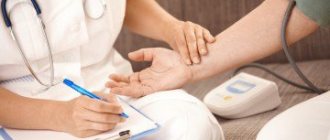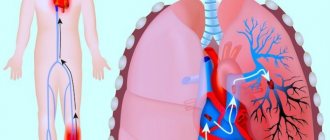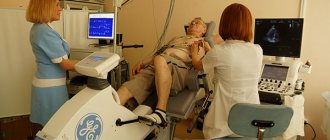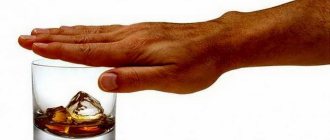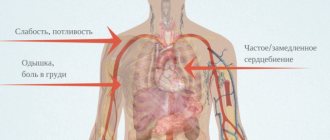Among all cardiac diseases, 15% are cardiac arrhythmias. The disease is characterized by a pathological condition in which the rhythm and frequency of muscle contraction of the organ is disrupted. Is cardiac arrhythmia dangerous, and what complications can there be? These are questions that interest patients with this diagnosis. The pathological condition does not threaten serious consequences if it is diagnosed on time and the patient undergoes full treatment. The main danger with arrhythmia is the increased risk of developing concomitant cardiac diseases.
Types of arrhythmia types
According to the norms, the heart rate occurs at a frequency of 60 – 80 beats/min. Any deviation from this indicator is considered an arrhythmia. Pathology, depending on the degree and nature of the disorders, is classified by type. Cardiac arrhythmia is diagnosed in men 1.7% more often than in women.
Types of arrhythmia:
- Flickering. The most dangerous type of disease in which irregular heart activity is observed in a chronic form.
- Paroxysmal. A type of disease with periodic attacks of rapid heartbeat.
- Sinus tachycardia. The type of pathology is expressed in increased heart rate.
- Extrasystole. The peculiarity of this species is that the work of the heart is greatly slowed down.
- Sinus bradycardia. It is considered a complicated form of extrasystole, in which the patient has organic abnormalities in the functioning of the heart.
Treatment of cardiac arrhythmia is prescribed after a thorough diagnosis, carried out to determine the full clinical picture, including the causes, type of disease and the consequences of its progression.
Prognosis and treatment
To predict the further course of the disease, you need to know what type of arrhythmia a person has, since this depends on the complexity of the disease, treatment and adherence to prevention. In the case of atrial fibrillation, the prospects for recovery and further life expectancy are determined individually for each patient. The prognosis can be positive if the patient seeks help from a doctor in a timely manner and follows his recommendations.
Often during attacks of paroxysmal tachycardia a person does not feel much discomfort, so many people mistakenly believe that this type of disease does not pose a threat. This is a dangerous stereotype, since without proper treatment, consequences such as disability and, in rare cases, death are possible. With sinus tachycardia, the prognosis can be very serious, since this type may indicate a disorder within the cardiac hemodynamics. It may be more satisfactory with physiological sinus tachycardia.
Attention! Sinus bradycardia is a dangerous type of disease that often occurs against the background of other heart diseases. Can lead to disability and cardiac arrest.
Extrasystole is the most harmless form of arrhythmia. In the absence of myocardial damage, a person’s working capacity is maintained. The attacks may stop for quite a long time, but if the cause of the disease remains, it can progress. Serious consequences can occur with malignant ventricular extrasystole.
To choose an effective treatment for arrhythmia, you need to conduct a thorough diagnosis. It is divided into several stages:
- Collection of information about the patient’s health and a complete examination.
- Instrumental diagnostic methods - echocardiography, ECG, various blood tests, ultrasound examination, testing of heart function with physical activity.
After diagnosis, when arrhythmia is detected, prevention and treatment must begin.
To avoid complications, you definitely need to give up bad habits, lose excess weight, start eating right and look after your health. If you have cardiac arrhythmia, you cannot ignore the symptoms of the disease or neglect examinations by doctors. It is necessary to eliminate frequent worries and stress from life.
Treatment methods may vary:
- anticoagulants;
- antiarrhythmic drugs;
- catheter ablation;
- surgical method of treatment.
Danger of arrhythmia
Is cardiac arrhythmia dangerous? The disease itself does not pose any risk to the patient’s health. There may be a temporary deterioration in the condition at the time of change in heart rate.
But if the heart function is not controlled, complications may begin to develop.
Note! Arrhythmia can develop not only in adults, but also in children. People over 50 years of age are at greatest risk.
In adults
The danger of the pathology depends on the type of arrhythmia. Experts also divide the disease into benign and malignant forms. The first form of the disease is not dangerous and is easily controlled by taking medications.
The malignant form is observed with organic failures. In such patients, general blood circulation is impaired. As a result, organs do not receive enough oxygen and the process of their dysfunction begins. It is with organic failures that heart attacks and strokes occur.
The main danger of cardiac arrhythmia is the sudden onset of an attack with immediate progression.
In children and adolescents
In childhood, arrhythmia is diagnosed much less frequently. Children before adolescence are at greater risk. The risk of sudden death is also present, but, as a rule, the cause is tachyarrhythmia and disruption of the sinus node rhythm.
For teenagers, the prognosis is more favorable. The pathology is predominantly temporary and is explained by the emotional instability of the puberty period. In order to prevent complications, it is recommended to consult not only a cardiologist, but also a psychologist.
During pregnancy
80% of pregnant women, especially if the woman is over 30 years old, experience heart rhythm disturbances. This is explained by the load that falls on all organs of the body, including the heart. Arrhythmia can cause difficult labor and congenital heart defects in the fetus. With tachycardia and atrial fibrillation, there is a possibility of miscarriage or hypoxia of the newborn. Pregnant women with arrhythmia should be monitored by a cardiologist throughout the entire period and in the first months after childbirth.
Causes and consequences of atrial fibrillation
Atrial fibrillation is a serious, persistent heart rhythm disorder that can lead to stroke. The disease belongs to the category of age-related pathology and occurs mostly in elderly people. Patients aged 25 to 35 years account for only 0.5 percent of this pathology. After age 69, the percentage rises to five. The reasons for the development of the disease are multifaceted. As a rule, for the development of “flicker”, a combination of several predisposing factors is necessary:
• pathology of heart valves, especially caused by rheumatism;
• heart failure and ischemic disease;
• expansion of the heart chambers;
• mitral valve prolapse;
• proliferation of connective and fibrous tissue in the atria;
• diseases of the pulmonary system;
• diabetes;
• pathology of the thyroid gland;
• alcohol consumption;
• imbalance of electrolytes in the body;
• weakness of the sinus pacemaker.
In addition, atrial fibrillation (AF) can be triggered by diseases of the nervous system and some mental illnesses.
The effects of some factors on heart tissue can be prevented. Thus, alcohol consumption, hyperthyroidism, and lung diseases can be eliminated with timely consultation with a doctor.
Primary MA is an independent disease with associated long-term consequences. It can be divided into three forms: acute, paroxysmal and chronic.
The paroxysmal form is characterized by the periodic appearance of a clinical picture in the form of heart pain, severe shortness of breath and characteristic changes on the cardiogram. In most cases, paroxysms go away on their own or under the influence of medications. Prolonged existence of paroxysms without drug correction will lead to the development of a stroke (bleeding in the brain).
The chronic form exists for a long time and is characterized by various conditions. Some of them can be stopped, others cannot be corrected. It exists as long as rhythm disturbances do not pose a threat to health. In other cases, cardiac surgeons will resort to installing a pacemaker. Such attempts are not always successful due to the fact that for a long time the patient has had the disease, part of the heart muscle is in a non-viable state and it is impossible to conduct electrical signals through it.
First signs and symptoms
Cardiac arrhythmia progresses at the initial stage completely asymptomatically. Further symptoms depend on what type of pathology develops: bradycardia (decreased heart rate) or tachycardia (increased heart rate).
Note! Signs of arrhythmia occur mainly with the development of complications.
Main symptoms:
- weakness of the whole body;
- frequent darkening of the eyes;
- sudden dizziness;
- shortness of breath even in the absence of physical activity.
When the patient has tachycardia, a short-term loss of consciousness may occur. During an attack, chest pain, severe coughing, and blue lips occur. Bradycardia has several distinctive signs: difficulty breathing, impaired coordination and attention, confusion of thinking.
Is sinus arrhythmia dangerous?
Arrhythmia is not something new in medicine, it has long had its own classification, there is a huge amount of data collected in practice about the disease, and there are many treatment options, but not one of them provides a 100% guarantee for the patient’s recovery.
Heart rhythm disturbances may appear as a result of a reaction to the body’s adaptation, but they still contribute to certain changes in hemodynamics, which can result in big troubles for the body. How dangerous is cardiac arrhythmia and why?
One moment, the human body can experience severe oxygen starvation, and the next, the state of health will be ideal, this is why sinus arrhythmia is dangerous. Such jumps have a very detrimental effect on the condition of the brain, nervous system and lungs. This means that during serious attacks, the patient may develop pulmonary edema, a sharp drop in blood pressure or a severe migraine.
Doctors very often observe cases when a person with arrhythmia suddenly loses consciousness. One can only imagine what the consequences could be if a sick person were driving a car.
Why are different forms of arrhythmia dangerous?
Each form of pathology involves a characteristic disorder that leads to various deviations in the functionality of the cardiovascular system. Extrasystole is considered the safest, and the most severe form is atrial fibrillation and paroxysmal.
Ciliated
The patient is prescribed lifelong drug therapy. Refusal of treatment can result in death. Atrial fibrillation also causes blood clots to form, which poses a risk of stroke.
Paroxysmal
Paroxysmal arrhythmia is dangerous for the patient to develop tachycardia with the risk of arrhythmic shock, which is characterized by a sharp decrease in pressure. In exceptional cases, swelling of the lung tissue is possible. With concomitant left ventricular failure there is a risk of asthma. Of particular danger is a sudden decrease in arterial and increase in venous pressure. This condition can lead to the death of the patient. The consequence of the lack of timely treatment can be a violation of cerebral circulation and thromboembolism of the vessels of the head, which leads to swelling, heart attack or ischemic stroke of the brain.
Sinus tachycardia
The danger of the disease lies in provoking the development of cardiovascular failure, which can also provoke more severe consequences - a brain tumor. With the sinus type of pathology, vegetative-vascular dystonia and anemia often occur.
Extrasystole
The pathology itself does not pose any danger. However, constant monitoring of the state of the cardiovascular system is required. With concomitant diseases, severe consequences cannot be excluded.
Sinus bradycardia
In most cases, patients suffer from severe migraines and depression. Pain in the heart area occurs rarely. The danger is the risk of developing Morgagni-Adams-Stokes syndrome, characterized by attacks with impaired contraction of the heart muscles at intervals of up to 10 seconds.
Consequences
Let's find out how dangerous arrhythmia is. In itself, it is a frequent companion to other diseases, the course of which complicates. Each case of the disease is individual, and there is not always a risk of complications. You can find out this by consulting a cardiologist and undergoing an examination.
On a note! Some forms of arrhythmia, for example, sinus bradycardia, in which the pulse rate is less than 40 beats per minute, are accompanied by frequent loss of consciousness due to low blood flow to the brain. As a result, there is a risk of complete cardiac arrest.
Sinus tachycardia can threaten the formation of a tumor in the brain. During attacks of paroxysmal tachycardia, general hemodynamics are quite often disrupted, which leads to:
- feeling unwell;
- weaknesses;
- shortness of breath and pulmonary edema.
Prolonged attacks can lead to heart failure. The most dangerous consequences of arrhythmia:
- Thromboembolism - due to the disease, blood clots appear that can break off at any time, block the brain or heart and lead to a heart attack or stroke.
- Heart failure – as a result of insufficient contraction of the heart muscles, the body experiences oxygen starvation.
Diagnostics
Complications of arrhythmic failures in the heart can be prevented by eliminating the factors that provoked the pathology. In order to determine the cause and tactics of the upcoming treatment, an examination is carried out.
Diagnostics include:
- Ultrasound of the thyroid gland;
- electrocardiography;
- ECG (daily monitoring);
- echocardiography.
Interesting fact! If it is not possible to establish an accurate diagnosis, methods of artificially provoking an attack of arrhythmia under the influence of physical activity are used. During the monitoring period, the patient's blood pressure, pulse and heart rate are measured.
How to reduce the risk of dangerous pathology?
Sinus arrhythmia is by no means a death sentence; you can live a long and happy life with it, or you can be completely cured if you follow your doctor’s recommendations. To eliminate dangers, you should follow several rules and recommendations:
- Do not ignore the symptoms - timely diagnosis is the key to successful treatment. That is why headaches and dizziness should not be attributed to fatigue. When the first signs and deviations from the norm appear, you need to visit specialists and get tested;
- Regular examinations - an ECG must be done annually during routine medical examinations. Even if nothing bothers you, modern equipment can detect violations. Arrhythmia is also dangerous because it is asymptomatic, and at the same time poses a threat to health;
- Giving up bad habits is the key to successful treatment and prevention of any pathologies, especially when it comes to the cardiac system. It is necessary to exclude alcohol and cigarettes from life, or reduce consumption to a minimum;
- Carefully follow the doctor's recommendations - doctors will prescribe the optimal treatment, be it medications, installation of a pacemaker, or other measures. Regular examination and diagnosis by specialists will also be required to identify negative or positive trends;
- Proper nutrition - you will have to protect yourself from coffee, tea, fatty and sweet foods, since a high calorie content is a direct path to excess weight, hypertension and heart problems;
- Folk remedies are a good alternative treatment option. You should take drugs only with the permission of a doctor; usually this method is combined with medication. Lemon juice, walnuts, honey, chocolate, dried apricots and hawthorn can be taken;
- Elimination of stress - you need to protect yourself from negativity, be in a great mood, relax more and enjoy life. If necessary, it is worth using sedatives of plant origin, for example, valerian and motherwort;
- Treat concomitant diseases in a timely manner - infections, hypertension, disorders of the thyroid gland - even the most harmless diseases can provoke not only arrhythmia, but also more serious disorders;
- Avoid excessive exercise - of course, you can and should play sports, but increasing activity should occur gradually;
- Maintaining a daily routine and rest - proper and healthy sleep is the key to not just good health, but also excellent health, as well as a proper routine.
It is much easier to prevent the development of arrhythmia than to treat it later. The earlier the diagnosis is made, the more favorable the prognosis the doctor will make.
Of course, these measures do not provide any guarantees, but sinus arrhythmia is not the most insidious disease that a person can develop. It cannot be ignored, since the danger of negative trends is great, but you should not panic because of such a diagnosis: modern medicine also treats more serious pathologies.
Treatment of cardiac arrhythmia with tablets
Therapeutic treatment for arrhythmia is possible only if there is no risk to the patient’s life. Cardiologists treat patients with this diagnosis. If there are concomitant pathologies that affect the functioning of the heart, consultation with other specialists is necessary.
In severe cases, drug therapy may not be effective. Then the patient is recommended to undergo surgery.
Treatment of atrial fibrillation
Treatment of the pathology consists of blocking attacks, normalizing heart rhythm and eliminating the consequences.
To reduce the heart rate, medications are used:
- beta blockers (Metoprolol, or Esmolol);
- calcium blockers (Diltiazem or Verapamil).
Only the attending physician can prescribe medications. Drugs that affect the heart can be dangerous if self-medicated. The dosage and course of therapy are determined individually.
Kinds
There are 4 types of this disease:
- sinus arrhythmia;
- flickering;
- heart block;
- extrasystole.
Each of these types can be characterized by individual specific signs, and each of them is characterized by a specific level of severity of the disease. After determining the type of disease, one can adequately judge whether arrhythmia in this case is dangerous and what impact it has on health. After which treatment is prescribed in order to restore vigor and strength to the body.
Let's start with atrial fibrillation, it is expressed in the form of erratic and uncertain contractions, disrupting the heart rhythm. As a result, a heart attack or even a stroke may develop. So, is cardiac arrhythmia dangerous? As one of the diseases of the cardiovascular system, it poses a rather great danger to the health of the patient, and also brings a lot of discomfort and makes you constantly worry about your well-being.
Let's look at why sinus arrhythmia is dangerous. This type of arrhythmia is considered one of the most dangerous, however, in some cases it can be safe for health if you follow the correct lifestyle.
We must not forget that this pathology indicates disturbances in the natural processes of blood circulation. The slightest deviation from the regimen prescribed by the doctor can significantly worsen the patient’s condition, as a result of which the risk of death for the patient increases. With almost any type of cardiac arrhythmia, the patient feels:
- general weakness;
- migraine;
- nausea;
- vomiting;
- Possible pain in the chest area.
Speaking of heart block, it can cause more serious consequences, such as cerebral ischemia.
The last one on the list is extrasystole, which is a prerequisite for the onset of the development of tachycardia, as well as cardiac dysfunction, since with it, the heart rate per minute exceeds 200. This means that the main organ in the human body experiences a huge load, provoking a fatal risk for health or the risk of acute heart disease.
Physiotherapy
Therapy for cardiac arrhythmia is carried out comprehensively. An additional treatment option is physical therapy. The maximum effect is observed during courses of electropulse therapy. Patient reviews confirm significant improvements after treatment.
The therapeutic result is also achieved with the help of ultraviolet irradiation, electrophoresis and electrosleep. Many patients notice an improvement in their condition after mud, hydrogen sulfide and sodium chloride baths.
The procedures have contraindications. Before conducting physical therapy, you should discuss the techniques used with your doctor, or follow only his instructions.
Diet
In case of heart problems, nutrition plays an important role. Poor blood circulation and heart contractions provoke a lack of microelements in the heart and other organs. Vitamin complexes are prescribed for recovery, but natural minerals and vitamins contained in products also bring no less benefit.
For arrhythmia, it is recommended to add to the diet:
- fish;
- greenery;
- Cod liver;
- dairy products;
- nuts;
- beef liver.
Since poor blood circulation also affects blood vessels, the risk of increased cholesterol in the blood increases. In order to prevent exceeding the norm of this indicator, you should avoid fatty, smoked, fried, sweet and baked goods. It is recommended to cook without adding oil by steaming or baking.
Prevention of hypertension development
Prevention of arterial hypertension is divided into primary and secondary. Primary prevention is needed for healthy people—those whose blood pressure does not yet exceed normal levels. The following set of health measures will help not only keep your blood pressure normal for many years, but also get rid of excess weight and significantly improve your overall well-being.
Physical exercise
Any physical exercise in persons with mild and moderate hypertension helps to increase physical performance. Exercises aimed at training endurance (general developmental exercises, breathing exercises, exercise equipment, swimming, walking, running) lead to a noticeable antihypertensive effect. However, during intense physical activity, systolic pressure increases sharply, so it is best to exercise a little (30 minutes) each day, gradually increasing the intensity from light to moderate.
Low salt diet
The amount of table salt should be limited to 5 grams (1 teaspoon) per day. It should be noted that many products (cheeses, smoked and pickled products, sausages, canned food, mayonnaise, chips) themselves contain a lot of salt. So remove the salt shaker from the table and never add salt to ready-made dishes. Replace salt with herbs and garlic. If it is difficult to do without salt, you can purchase salt with a reduced sodium content, the taste of which is almost no different from regular salt.
Limiting animal fats
Gradually replace butter, cheeses, sausages, sour cream, lard and fried cutlets from your diet with additional vegetables and fruits, vegetable oil and lean fish. Prefer low-fat dairy products. This way you can control cholesterol levels in the blood (prevention of atherosclerosis), normalize weight and at the same time enrich your diet with potassium, which is very useful for hypertension.
Rejection of bad habits
Enough has been said about the dangers of tobacco and alcohol. But if you find more than two of the risk factors for hypertension listed above, know that it’s time to be more merciful to your heart and blood vessels. Bad habits and arterial hypertension are a terrible combination, which in most cases leads to tragic consequences.
If the diagnosis of “hypertension” has already been made, a few more points should be added to the above measures. This is the so-called secondary prevention, the main task of which is to protect target organs from negative consequences and avoid the dangerous complications of hypertension - coronary heart disease, heart attack, cerebral stroke.
Psychological relief
Stress is one of the main causes of high blood pressure. That’s why it’s so important to master methods of psychological relief - auto-training, self-hypnosis, meditation. It is important to strive to see the positive sides in everything, to find joy in life, to work on your character, changing it towards greater tolerance for other people’s shortcomings, optimism, and balance. Hiking, sports, hobbies and spending time with pets also help maintain mental balance.
Blood pressure measurement
Blood pressure must be measured daily, and the resulting numbers must be written down in a special notebook, which must be shown to your doctor every 2-3 months. Secondary prevention of hypertension consists of individual selection of appropriate doses of antihypertensive drugs and systematic maintenance of normal or near-normal blood pressure values with their help.
Non-drug therapy
In addition to the already mentioned hypertensive diet, therapy may include breathing exercises, light massage, normalization of sleep, adherence to a daily routine, taking natural and synthetic vitamins, antioxidants, nutritional supplements and restorative herbs. In short, it’s worthwhile to “improve” your lifestyle as much as possible.
Means for prevention
Taking medications to prevent arrhythmia is recommended for people over 40-45 years of age who have a predisposition to heart pathologies or diagnosed heart disease.
Preparations for prevention:
- Amiodarone;
- Quinidine;
- Ibutilide Sotalol;
- Panangin;
- Digoxin;
- Metoprolol.
Important! Medicines have different effects on the heart. It should be remembered that medications can speed up or slow down heart rate, therefore, before using medications, diagnostics are necessary to determine the nature of cardiac disorders.
